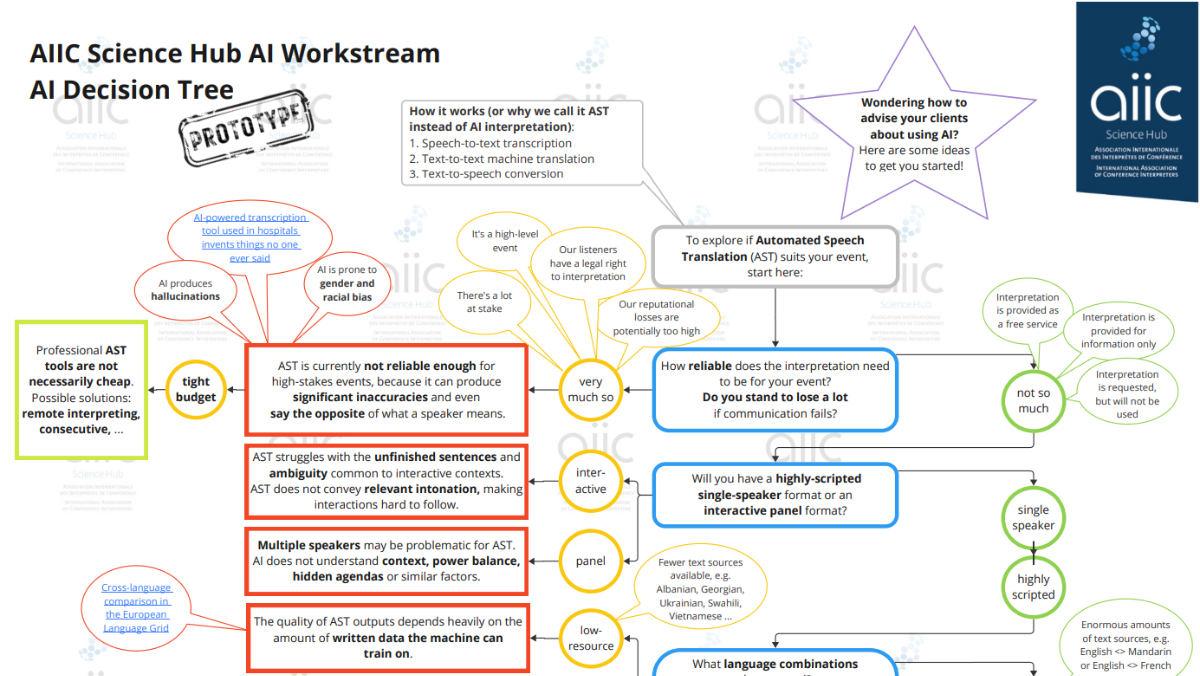A Guide To Help You Talk to Interpreting Clients About AI
Could we use AI for interpretation at our next event?
Like it or not, our clients may already be asking this question.
And while it’s tempting to dismiss AI outright, the International Association of Conference Interpreters (AIIC) is asking us to do the opposite.
AIIC wants interpreters to join the conversation about Automatic Speech Translation (AST) so we can position ourselves as guides, helping clients make informed decisions about what’s best for their needs.
That’s why the AIIC Science Hub AI Workstream, a group that monitors and responds to AI’s impact on interpreting, has developed a resource called the AI Decision Tree.
How the AI Decision Tree works
The decision tree addresses the many factors that impact AST performance, from event format to language combinations to confidentiality.
For instance, it illustrates how AST might work for a single, highly scripted speaker, but not for an interactive panel.
Or how it could be an option for a high-resource language pair like English<>French, but less effective for low-resource languages such as Albanian or Vietnamese.
Still, there’s no single decisive factor. For example, AST might struggle even with a highly scripted speaker – if their language is Vietnamese.
To make these factors easier to navigate, the AI Decision Tree maps them out in a clear, logical sequence, using questions to guide you step-by-step toward a recommendation.
The tree starts with broad considerations — How reliable does the interpretation need to be for your event? — and moves to more specific ones, like Will you be able to ensure sufficient audio quality? Eventually, it leads to a conclusion: AST is NOT suitable for this event, and here’s why or AST may be an option in this particular case.
Explore the AI Decision Tree to assess whether Automated Speech Translation is right for your interpreting event.
The limits of Automatic Speech Translation
While the decision tree isn’t meant to rule out AST entirely, it does highlight its limitations for interpretation.
In fact, AST only becomes an option when events meet these conditions:
Interpretation is not critical to the event’s success.
Speeches are highly scripted.
Languages used are relatively common (since AST’s output depends heavily on the availability of training data).
Speeches are devoid of emotion, humor, and cultural references.
In practice, most paths in the decision tree lead to the same conclusion: human interpreters are the more reliable choice – and the only viable one for high-stakes events.
Decision tree as conversation script
Though the AI Decision Tree is publicly available, I wouldn’t recommend sharing it with clients, since it includes terminology clients might not understand.
It’s far more effective as a starting point for a thoughtful, client-centered conversation.
As Irina Paramonova, the AIIC Science Hub coordinator, put it: “If you come to the theater and are provided a script by the actor instead of watching the play, would you really be satisfied? Because that’s the equivalent of sending your script to your client instead of going through a conversation, listening to the answers, adapting the information to the specific situation.”
She recommends studying and internalizing the information – so that when a client asks about using AI for interpretation, you’re fully prepared.
Interpreting is about more than words
While acknowledging that AI “interpreting” might work in some contexts may seem counterintuitive, it’s actually an opportunity to explain the complexity of interpreting to clients.
By discussing what AI can and can’t do – and how that plays out in real-world scenarios – we position ourselves as knowledgeable partners who are committed to helping clients succeed.
That’s where AI guidance tools like the AI Decision Tree and AI training come in. To paraphrase Irina Paramonova, they help us step up our human game so that no matter how AI evolves, we remain irreplaceable.

